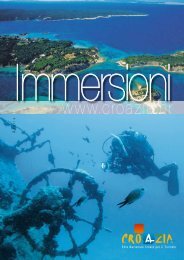Diving
Diving
Diving
Create successful ePaper yourself
Turn your PDF publications into a flip-book with our unique Google optimized e-Paper software.
Other wrecks of interest<br />
Coriolanus: A British Royal Navy warship of the Shakespeare class, a<br />
wreck under the protection of the Ministry of Culture of the Republic of<br />
Croatia. The vessel was a steam-engine powered mine-sweeper adapted<br />
for sailing in adverse condition (trawler), capacity 554 t, 46 m long,<br />
8.5m in beam. Its armaments included 20 mm anti-aircraft cannons and<br />
it carried 30 anti-submarine deep water mines. The ship was launched<br />
in 1940 and was a part of a 12 vessel fleet of the same class. Judging<br />
by the electronic equipment installed it is believed that towards the end<br />
of the war the ship was also engaged in espionage activities. On May<br />
5, 1945 it struck a floating mine and sunk within a very short time. The<br />
wreck lays at the following location: 45o 19’ 9’’ N, and 13o 25’ 25’’ E,<br />
about 6 nm from the Istrian coast at a depth of from 11 to 25 m. Attention<br />
has to be paid to the fishing nets which cover a good part of the wreck,<br />
occasionally visible from the surface. Periodic good visibility and the<br />
shallow waters make for favourable diving conditions, even for less<br />
experienced divers.<br />
Coriolanus<br />
Flamingo: a WW1 Austrian-Hungarian Navy torpedo boat which struck<br />
one of its own mines during a patrol west of Premantura. For a long time it<br />
was believed that the wreck, sunk quite deep into ooze was a submarine<br />
due to its specific shape and compact steel construction. This attractive<br />
location, very often enjoying good visibility, is suitable for advanced<br />
categories of divers. The length of the vessel is 40 m and is lying at a<br />
depth of 40 to 45 m.<br />
Giuseppe Dezza: a WW2 torpedo ship built in Italy. Following Italy’s<br />
capitulation the vessel came into German hands and was renamed TA35.<br />
According to some the ship was sunk by an English aerial torpedo which<br />
penetrated the ammunition locker, which caused a massive explosion.<br />
The boat broke in two and the explosion blew the bow section some 80<br />
m north of the remainder of the vessel. The wreck, in a well preserved<br />
condition and with its deck armaments still intact, is lying at a depth of 30<br />
to 36 m. Length of the vessel is 73 m, and with a beam of 7.3 m. This site<br />
is suitable for higher category divers.<br />
Novigrad<br />
U-81: a German Navy submarine, notorious for having sunk the British<br />
aircraft carrier the Ark Royal in the Atlantic Ocean, lies 4 miles south of<br />
the Kamenjak cape (Premantura). It was sunk during a bombardment<br />
in 1945 and broke in two. Following the end of WW2 the Yugoslav<br />
Navy attempted to recover and repair the submarine. It was lifted and<br />
transported to Pula, but during transport the towing cables snapped<br />
close to Stoja cape, where a major part of the submarine went down<br />
again, while it smaller section sank some 500 m to the west.<br />
John Gilmore: a merchant ship built in the John Gilmore shipyard in<br />
Scotland. Since its actual name is unknown, divers refer to it by the name<br />
of the shipyard, which is engraved on a plaque that divers found on the<br />
vessel. The ship was sunk in 1915, and since its bow is badly damaged it<br />
is believed that it struck one of the 1450 mines laid in WW1 as a defence<br />
measure for the naval port of Pula. Its length is 65 m, beam 8 m, and lies<br />
at a depth of 36 to 43 m.<br />
Josephina: a merchant ship of unknown name and with no data with<br />
regard to its history. Sunk in 1915 its bow is damaged, indeed ripped<br />
open, which indicates that it struck an underwater mine. The vessel<br />
lies on a sandy bottom west of the entrance to the port of Pula, in a belt<br />
defended once by a minefield, which is why all the wrecks which met<br />
their doom in this defensive belt lie in a straight line. The vessel was 65 m<br />
long with a beam of 8 m.<br />
∆ Striped red mullet (Mullus surmuletus) searching<br />
for food in the sand<br />
Jellyfish – a hunter lurking in the sea currents,<br />
keeping the Adriatic Sea clean<br />
∆<br />
Croatian National Tourist Board<br />
9




